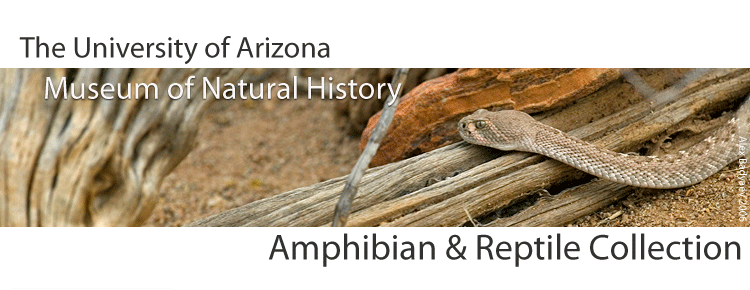The holdings for this Legacy Collection are international
in scope, spanning forty-six countries from six continents, and
include material from forty-six U.S. states and territories, as
well as thirty Mexican states. Other regions with coverage include
Central America, South America, Europe, Asia, Africa, Australia,
Malaysia, and the Middle East. The principal strength of this collection,
however, resides in extensive holdings from the Southwestern United
States, and Northern Mexico. Approximently 70% of our specimens
are from the States of Arizona, USA and Sonora, Mexico, making this
assemblage one of the premiere regional collections in the country,
and the single most important herpetological collection covering
this extremely diverse and important biological realm.
The bulk of our holdings are formalin-fixed and
preserved in isopropyl alcohol (33% for amphibians and 55% for reptiles),
but the collection also includes osteological preparations, dehydrated
specimens, photographic specimen vouchers (PSV), formalin preserved
amphibian larvae, cleared and stained material, and a small but
growing tissue collection. These collections are maintained by Collections
Manager George Bradley.
Any inquiries or comments should be directed to him. Full contact
information is available at the bottom of this page.
At present, approximately 240 species of amphibians
from 3 Orders, 24 Families, and 66 Genera, as well as 637 species
of reptiles from 3 Orders, 35 Families, and 258 Genera are represented.
Taxonomically, the collection has several important strengths. The
collection possesses one of the largest and most diverse assemblages
of the Teiid genus Cnemidophorus (Aspidoscelis
in part) available with 8,860 specimens distributed in 35 species.
Our holdings of the Family Xantusiidae demonstrate another strength,
where 11 species are represented by over 1,200 specimens. Several
other “southwestern specialties” such as the Viperid
genus Crotalus (20 species, 2078 specimens), the Colubrid
genera Phyllorhynchus (2 species, 479 specimens), Thamnophis
(18 species, 1443 specimens), Salvadora (5 species, 578
specimens), and Chionactis (2 species, 314 specimens),
as well as the Iguanid genera Urosaurus 6 species, 2628
specimens), Phrynosoma (12 species, 1950 specimens),
Sauromalus (4 species, 345 specimens), and Sceloporus
(44 species, 5738 specimens) are very well represented. This collection
is also well known for its holdings of the genus Heloderma
, with 25 H. horridum and 257 H. suspectum.
The collection maintains a total of 142
type specimens, which are comprised of 12 holotypes, 109 paratypes,
5 topotypes, and 16 topoparatypes. These type specimens may be made
available for non-destructive study at UAZ facilities only, and
are not generally available for specimen loans.
The data for all holdings in the collection have
been computerized. Although very much still a work in progress,
an attempt has been made to include all available information for
each specimen in this database. The searchable database
available within this website now contains much of this information.
Data requests are available if additional information is needed.
George Bradley
Herpetology Collections Manager
Department of Ecology and Evolutionary Biology
University of Arizona
Tucson, Arizona 85721
(520) 621-3187
gbradley@u.arizona.edu

